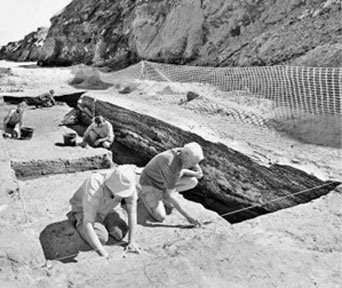Evidence of early humans who lived in colder climate found
by R. Prasad
How far north did early humans who migrated out of Africa some 1.75
million years ago venture? Moving towards the polar region meant
encountering colder climates, and early humans were not equipped to live
in such hostile climate.
All evidence of their dispersal from Africa has been restricted to
tropical, savannah and Mediterranean regions not beyond 45 {+o} N
latitude.
According to a report in Nature published in 2005, early humans had
indeed ventured beyond 45 {+o} N latitude some 7,00,000 years ago and
reached Pakefield, Suffolk in the U.K that lies at 52 {+o} N latitude.
But that was when Suffolk still had a balmy Mediterranean climate.
 |
|
Evidence unearthed: Archaeological
excavations in progress in 2006 at two trenches in
Happisburg, Norfolk, U.K. |
A report published today (July 8) in Nature has for the first time
found evidence of human occupation in the boreal zone more than 7,80,000
years ago.
Boreal zone
Boreal zone is marked by a definite winter with snow and a short
summer that is generally hot.
The artefacts were recovered from Happisburg that lies on the
northeast coast of Norfolk, U.K. Like Suffolk, Happisburg is also at 52
{+o} N latitude.
About 80 artefacts, predominantly large flakes, up to 145 mm size
with sharp cutting edges have been recovered from the Early and Middle
Pleistocene sediments - fluvial gravels and estuarine sands. The flakes
have undergone little abrasion implying the deposition at the site of
human inhabitation with little transportation by the river.
Artefacts are just one of the many treasures recovered. The sediments
contain well preserved plant and animal remains. These remains are
indicative of a forest-fringed estuary.
According to the authors, geological evidence indicates that human
occupation was in the upper estuarine zone of the River Thames. That
would mean that the River Thames had flowed into the sea about 150 km
north of its current estuary.
Among the plant remains recovered from the sediments are pollens,
seeds, pine-cones, and wood. The animal remains include foraminifera,
marine molluscs, barnacles, beetles and vertebrates. Reconstructing the
paleoenvironment and paleoclimate has thus become quite easy, thanks to
the plethora of plant/animal remains.
The plant remains indicate “regional conifer-dominated forest with
deciduous elements forming a minor component,” the authors note. There
are remains that are indicative of local grasslands as well.
The animal remains such as beetles point to a large, slow-moving
river, while the marine molluscs, barnacles and foraminifera reflect a
proximity to the estuary and salt marsh.
Paleoclimate
Reconstruction of the paleoclimate using the plant/animal remains
suggests a mean summer temperature between 16 degree C and 18 degree C,
and mean winter temperature between 0 degree C and minus 3 degree C (-3
{+o} C).
These summer and winter temperatures are what one may expect to see
in the southern fringes of a boreal zone.
“These temperature estimates ... are analogous to the situation that
exists in southern Scandinavia today near the transition between the
temperate and boreal vegetation zones,” the authors state.
Evidence from vegetation suggests an interglacial period with human
occupation happening during the later part of a warm interglacial period
some 8,40,000 to 9,50,000 years ago.
Unfortunately, the excavation sites have not provided any clues to
the ways in which early humans survived in such cold climate during
winter.
Cold climate is not the only challenge they would have faced.
Vegetation of northern Europe during the interglacial periods was marked
by seasonal plant resources.
The coniferous forests, in particular, are characterised by low
usable biomass and poor edible plant resources during winter. Even
animals would have been more dispersed during winter, thus making food
availability a great challenge.
Winter survival
So how did these early humans survive the cold winters?
According to the authors, there is evidence that early humans who
lived in Happisburg were in a transition area (ecotone) between
resource-poor forests and resource-rich habitats including large tidal
river, salt marsh and coast.
The only way early humans could have survived during winter was by
turning to the river and sea for food.
Till date very little information was available that reflected the
way early humans adapted and survived in the new climatic zones after
migrating out of Africa. This study provides some information, though
sketchy.
Along with the 2005 study, the latest paper strongly indicates that
places in the U.K., particularly those around the River Thames and east
coast bordering the North Sea Basin, are the ideal locations to look for
more artefacts used by early humans.
The Hindu
|

